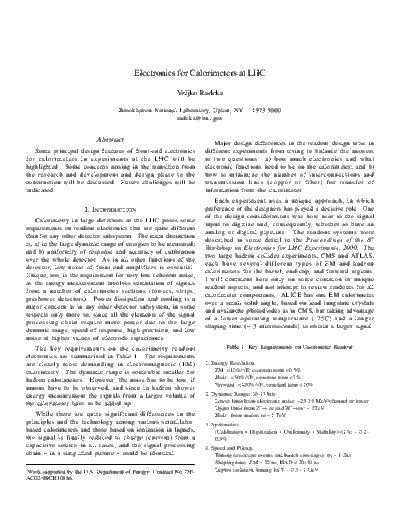Service Manuals, User Guides, Schematic Diagrams or docs for : . Rare and Ancient Equipment CERN Radeka
<< Back | HomeMost service manuals and schematics are PDF files, so You will need Adobre Acrobat Reader to view : Acrobat Download Some of the files are DjVu format. Readers and resources available here : DjVu Resources
For the compressed files, most common are zip and rar. Please, extract files with Your favorite compression software ( WinZip, WinRAR ... ) before viewing. If a document has multiple parts, You should download all, before extracting.
Good luck. Repair on Your own risk. Make sure You know what You are doing.
Image preview - the first page of the document

>> Download Radeka documenatation <<
Text preview - extract from the document
Electronics for Calorimeters at LHC
Veljko Radeka
Brookhaven National Laboratory, Upton, NY 11973-5000
[email protected]
Abstract Major design differences in the readout design arise in
Some principal design features of front-end electronics different experiments from trying to balance the answers
for calorimeters in experiments at the LHC will be to two questions: a) how much electronics and what
highlighted. Some concerns arising in the transition from electronic functions need to be on the calorimeter; and b)
the research and development and design phase to the how to minimize the number of interconnections and
construction will be discussed. Future challenges will be transmission lines (copper or fiber) for transfer of
indicated. information from the calorimeter.
Each experiment uses a unique approach, in which
I. INTRODUCTION preference of the designers has played a decisive role. One
of the design considerations was how near to the signal
Calorimetry in large detectors at the LHC poses some
input to digitize and, consequently, whether to have an
requirements on readout electronics that are quite different
analog or digital pipeline. The readout systems were
than for any other detector subsystem. The main distinction
described in some detail in the Proceedings of the 6 th
is, a) in the large dynamic range of energies to be measured;
Workshop on Electronics for LHC Experiments, 2000. The
and b) uniformity of response and accuracy of calibration
two large hadron collider experiments, CMS and ATLAS,
over the whole detector. As in all other functions of the
each have several different types of EM and hadron
detector, low noise of front-end amplifiers is essential.
calorimeters for the barrel, end-cap, and forward regions.
Unique, too, is the requirement for very low coherent noise,
I will comment here only on some common or unique
as the energy measurement involves summation of signals
readout aspects, and not attempt to review readouts for all
from a number of calorimeter sections (towers, strips,
calorimeter components. ALICE has one EM calorimeter
preshower detectors). Power dissipation and cooling is a
over a small solid angle, based on lead tungstate crystals
major concern as in any other detector subsystem, in some
and avalanche photodiodes as in CMS, but taking advantage
respects only more so, since all the elements of the signal
of a lower operating temperature (-25C) and a longer
processing chain require more power due to the large
shaping time (~ 3 microseconds) to obtain a larger signal.
dynamic range, speed of response, high precision, and low
noise at higher values of electrode capacitance.
The key requirements on the calorimetry readout Table 1: Key Requirements on Calorimeter Readout
electronics are summarized in Table 1. The requirements
are clearly most demanding in electromagnetic (EM) 1. Energy Resolution
calorimetry. The dynamic range is somewhat smaller for EM: <10%/E; constant term <0.5%
hadron calorimeters. However, the noise has to be low, if Hadr.: <50%/E; constant term <3%
Forward: <100%/E; constant term <10%
muons have to be observed, and since in hadron shower
energy measurement the signals from a larger volume of 2. Dynamic Range: 16-17 bits
the calorimeter have to be added up. Lower limit from electronic noise: ~25-35 MeV/channel or tower
Upper limit from Z ee and We: ~ 3TeV
While there are quite significant differences in the Hadr.: from muons to ~ 1 TeV
principles and the technology among various scintillator- 3. Systematics:
based calorimeters and those based on ionization in liquids, (Calibration + Digitization + Uniformity + Stability) <1%; ~ 0.2 -
the signal is finally reduced to charge (current) from a 0.3%
capacitive source in all cases, and the signal processing 4. Speed and Pileup:
chain ◦ Jabse Service Manual Search 2024 ◦ Jabse Pravopis ◦ onTap.bg ◦ Other service manual resources online : Fixya ◦ eServiceinfo